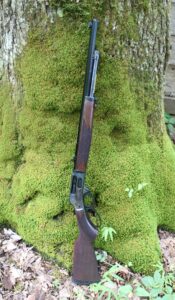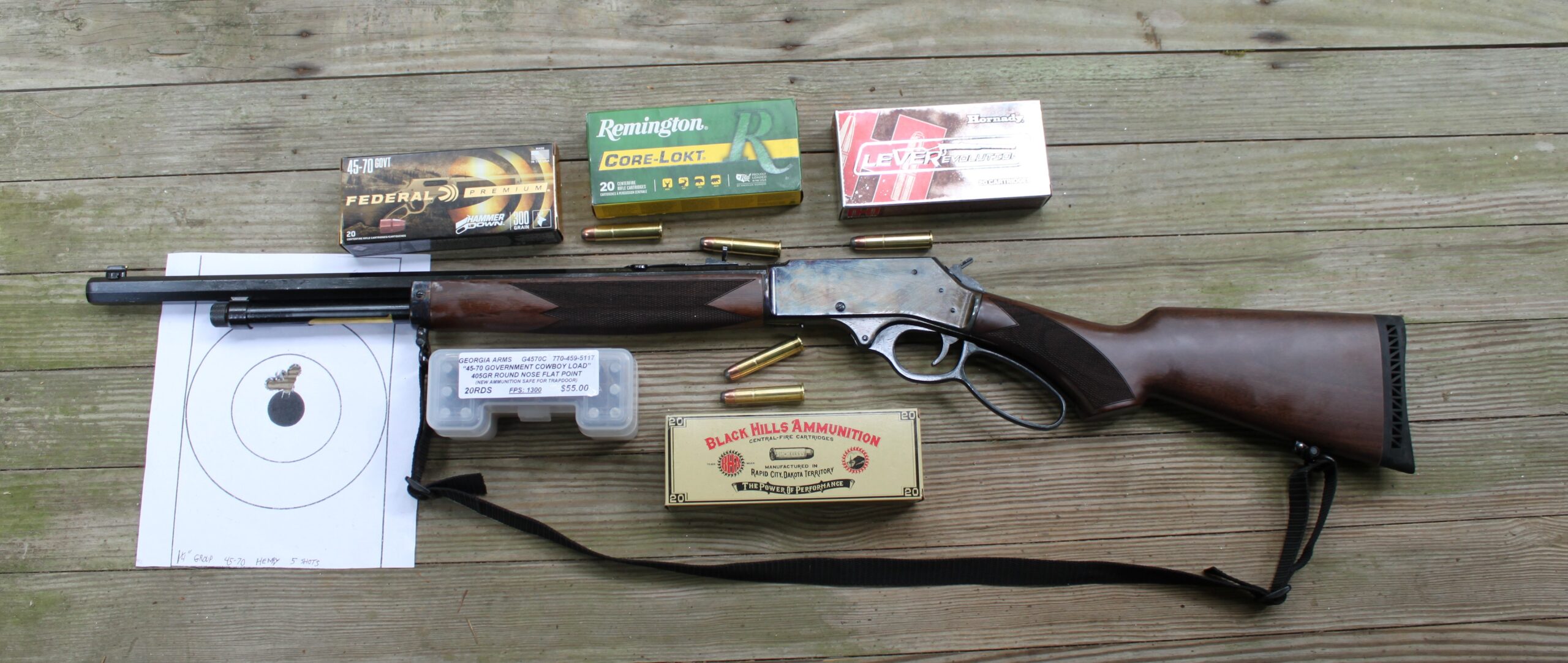
By Jim Dickson | Contributing Writer
There have been many .45-70 lever action rifles since the first one, the Model 1881 Marlin, was introduced 137 years ago but the new casehardened frame Henry Repeating Arms model may well prove to be the best one yet.
Workmanship is superb and the action works as smooth as greased glass. That fit is important because lever action rifles can be as finicky about timing as a revolver. If you have too strong a magazine spring and the relationship of the cam surfaces of the lever meeting the cam surfaces of the cartridge carrier aren’t precisely timed together you can end up with the first round feeding into the cartridge carrier and the next round coming out of the magazine at the same time jamming the gun. The only way to clear this jam is to take out the magazine tube plug and dump the cartridges out. You now have a single shot weapon until a highly skilled gunsmith can work on your gun.
This is not as uncommon as you might think. I had a new big name lever action from another company that was defective in this manner.
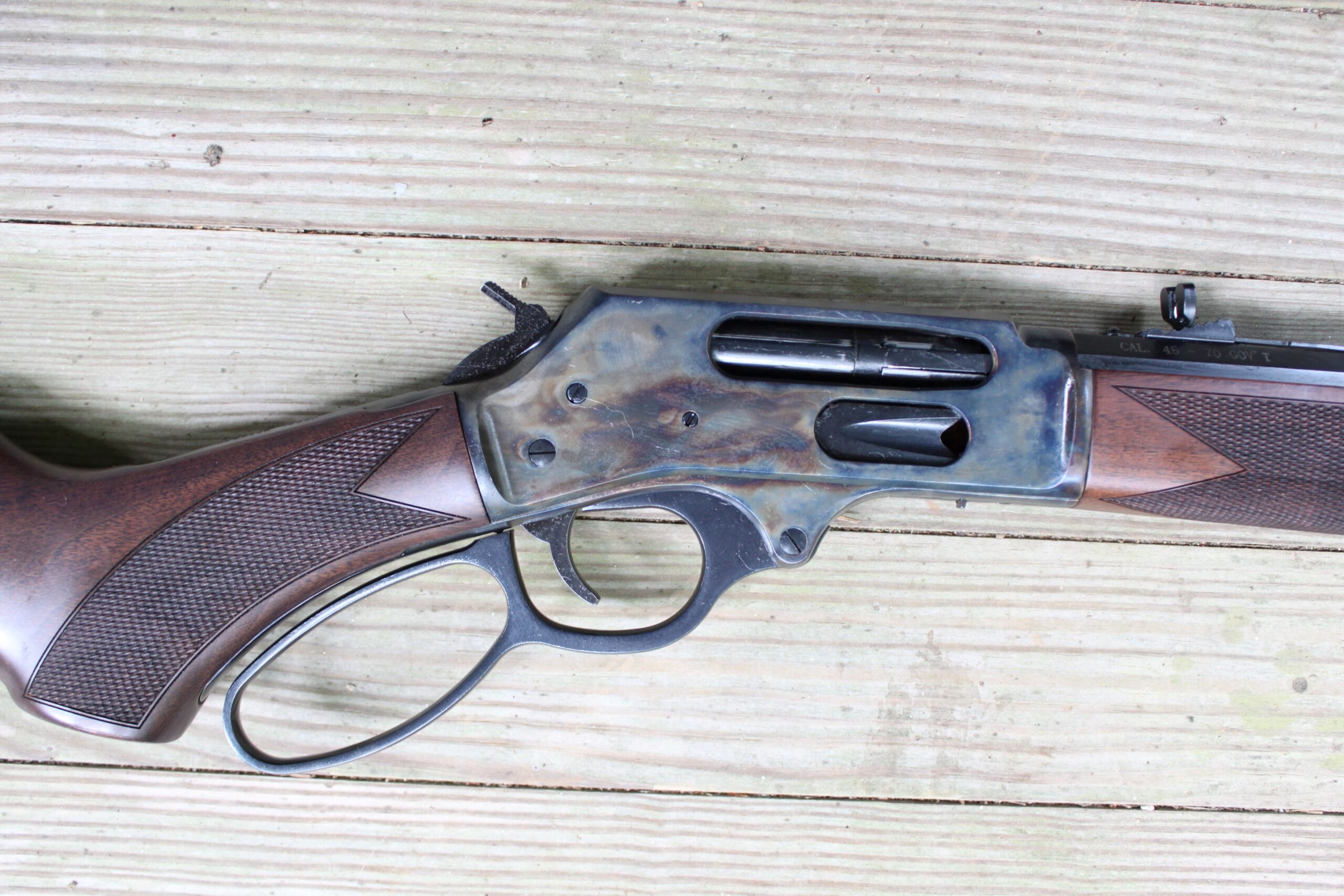
The Henry has supplemented the Kings Patent Loading Gate found on the side of all except the very first lever action rifles with a slot cut into the magazine tube that allows the quick release magazine cap to be removed and its inner magazine tube to be partially withdrawn allowing you to bypass the Kings side mounted loading gate with its traditionally sharp edges. Alternately you can remove the inner magazine tube completely and just drop the cartridges directly in through the exposed end of the tube. The magazine holds four rounds plus one in the chamber, giving you five shots before reloading.
Sights on the Henry consist of a traditional bead front and buckhorn rear. While I would prefer a 1/8-inch aperture peep sight mounted where the buckhorn sight is for fast use with both eyes open, the buckhorn sight does work quite well. Unlike some guns I have tested, the Henry’s sights were spot on the target when they left the factory. Scope users will welcome the fact that the Henry comes drilled and tapped for a Weaver 63B scope mount.
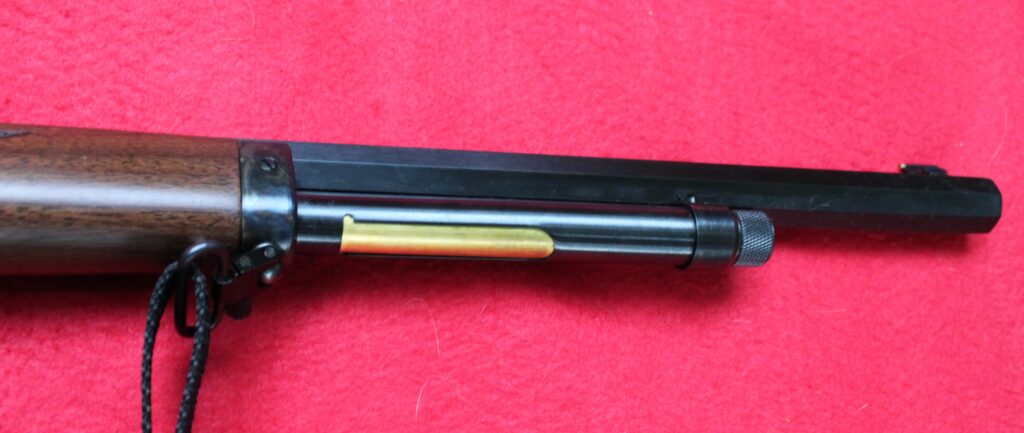
There is a hammer block safety which prevents the cocked hammer from firing unless the trigger is pulled. I like this far better than the traditional half cock for safety.
The semi-pistol grip stock has a 14-inch length of pull and is fitted with a rubber recoil pad. The lever is bulged outward allowing easier use with a gloved hand.
Aside from scope mounting, the side ejection offers one important advantage over top ejection lever rifles. With a top ejection lever action sooner or later you will have the brass land on top of your head or worse, have a hot brass case down your collar if you shoot enough.
The rifle comes equipped with sling swivel studs. I added sling swivels from Brownell’s Gunsmith Supplies and a Viet Nam War silent sling to round it out.
The 22-inch-long octagon barrel with its rifling twist rate of 1-to-20 inches is one of this rifle’s best features. There is something special about a traditional octagon barrel. Certainly it improves performance. The harmonic barrel vibrations that accompany each shot as the bullet passes down the bore are so aligned with the bullet’s exiting the bore in this barrel that accuracy does not suffer any loss. It is superbly accurate and contributes greatly to the perfect balance and liveliness in the hands this gun exhibits as well as making it remarkably steady to hold on target. Plus, it enables a handy overall length of 41.1 inches and brings the weight up to 8 pounds 2 ounces.
That weight is important as I have known men who bought light 7 pound 45-70’s and soon sold them as they kicked too much. Weight is your friend where recoil is concerned. This gun kicks about the same as an 8 pound 2 ounce .30-06 so it is not unpleasant to fire. While comparing the .45-70 to the .30-06 it is worth noting that the old 405 grain 45-70 load compared to the 30-06 180 grain load has far greater stopping power. The Taylor Knock Out values for the 405-grain standard velocity .45-70 load are 34.3 at the muzzle and 25.7 at 300 yards. Compare this to the 180-grain .30-06 delivering 20.8 at the muzzle and 15.7 at 300 yards and you can see that the .45-70 has significantly more power at 300 yards than the .30-06 has at the muzzle.
Some Alaskans who have used both the .375 H&H and the .45-70 say they are equal in stopping power on the big Alaskan grizzly bears. Even when compared to the .375 H&H Magnum the .45-70 has significant advantages.
Since it first appeared 163 years ago, the lever action has been valued by its rapidity of fire which is second only to the semi-automatic rifle of more modern times. The simple down and back action of the lever rifle is inherently faster than the up, back, forward, and down motions of working a bolt action. Additionally, the long bolt throw of the bolt action brings the bolt perilously close to the shooter’s eye so that many shooters either lean back or drop the rifle from their shoulder while working the bolt. The bolt throw on the lever action is so short that it doesn’t come anywhere near the shooter’s eye resulting in no necessary movement of the head backwards or dropping the rifle from the shoulder when operating the action.
Speed isn’t the only advantage the .45-70 has over the .375 H&H magnum for North American game. As previously stated the 8 pound 2-ounce Henry has approximately the same recoil as a 30-06 not a .375 H&H Magnum which has a lot more recoil. More recoil means slower recover time and slower rate of fire. Small wonder that many Alaskans have always liked a .45-70 lever action. You have to have met a big brown bear in thick cover to fully appreciate this.
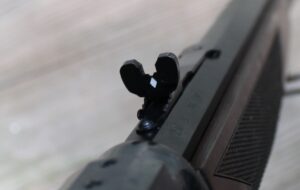
Some people will say that the .30-06 and .375 H&H Magnum are better long range cartridges. Flatter shooting, yes, better, no. The .45-70 was still being fired at long range at the National Matches at Camp Perry in the 1920’s and I still have a 1923 Frankfort Arsenal match .45-70 round made for them. In the old days, men learned to judge range by eye. Today we have laser rangefinders. Match these to the bullet drop table for your ammo and you have no excuse. It should be noted that most of the deer shot each year are actually shot at less than 100 yards. If you are in the woods, you won’t even be able to see 100 yards.
Thanks to the low recoil you can have all this power for about the same kick as a .30-06. More power means less long tracking and a bigger blood trail to follow thanks to the larger bullet entrance hole. The .45-70 plows through brush that can break up super high velocity bullets. It is an efficient and emphatic deer killer. Maybe you don’t have Alaskan grizzly bears where you hunt but wild hogs are found throughout the lower 48 states and I know of at least three that weighed over 1,000 pounds each. I sure don’t want to tackle that with a 5.56. Wild hogs don’t always run away from you. I have seen them attack a man on sight. A really big hog can take a lot of stopping, too.
I had 260 rounds to test fire this rifle consisting of:
- 80 rounds of Black Hills 405-grain lead flat point at 1,250 FPS. I recommend this for anyone with a 7 pound .45-70. The game won’t know the difference in velocity but your shoulder will. It is highly accurate giving groups under 2 inches in the open sighted Henry.
- 20 rounds of Georgia Arms 405-grain lead flat point at 1,300 FPS. High quality ammo from a small company that groups under 2 MOA.
- 60 rounds of Remington 405-grain Core Lokt at 1,600 FPS. This would make a splendid Kodiak bear load. Remington holds this ammo to under 2 MOA out of their test barrels.
- 60 rounds of Hornady LeverEvolution 325-grain bullet at 2,050 FPS. This is a very flat shooting round thanks to the soft plastic tip designed to give good aerodynamic shape yet still be safe for tubular magazines. Hornady holds this to 1.25 MOA maximum out of their test barrels. This is the one I would pick for elk and mountain sheep.
- 40 rounds of Federal HammerDown 300-grain JHP at 1,850 FPS. This ammo was developed jointly by Henry and Federal for maximum reliability in lever actions. It also gave groups under 2 inches with the open sighted Henry.
Traditionally lever actions had to be cleaned from the muzzle. Since the cleaning rod can damage the rifling at the crown over time it is necessary to use a pull through or use a cleaning rod guide from J.Dewey Mfg. Co. to prevent the cleaning rod from damaging the ends of the rifling.
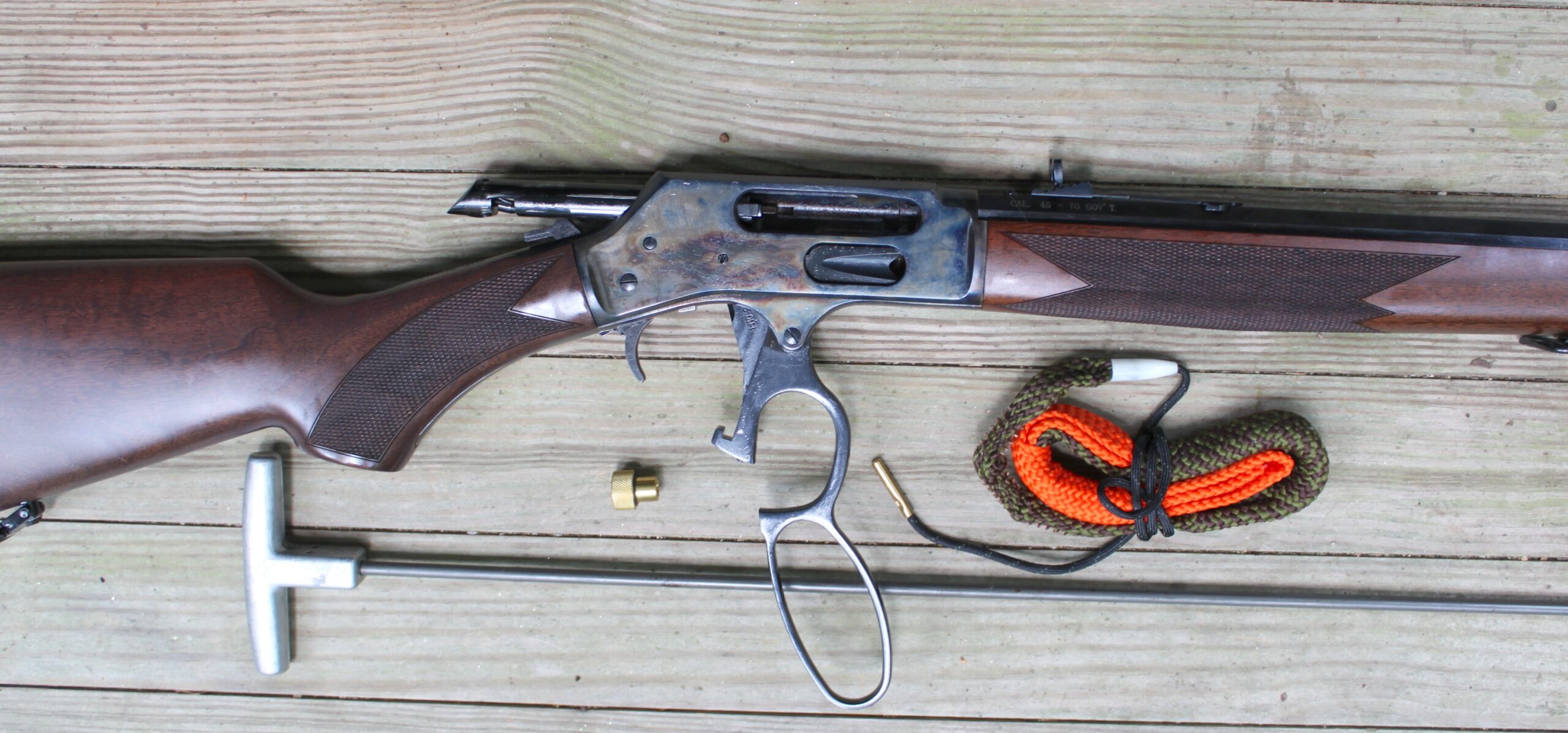
The Hoppe’s Bore Snake is another modern convenience that enables lever actions to be quickly and safely cleaned. The Henry can also be cleaned from the breech by drawing the lever down and removing the lever screw which enables the lever to come out and the bolt to be pulled out from the rear. Be sure to keep the gun lying on its left side as you do this so the ejector doesn’t fall out The bolt is the only thing holding it in place and it can be a real pain to put back once it escapes.
Suitable for all North American big game the Henry casehardened steel frame octagon barrel .45-70 represents all that is good in a lever action hunting rifle and demonstrates clearly why this type has remained an American favorite for 163 years.

